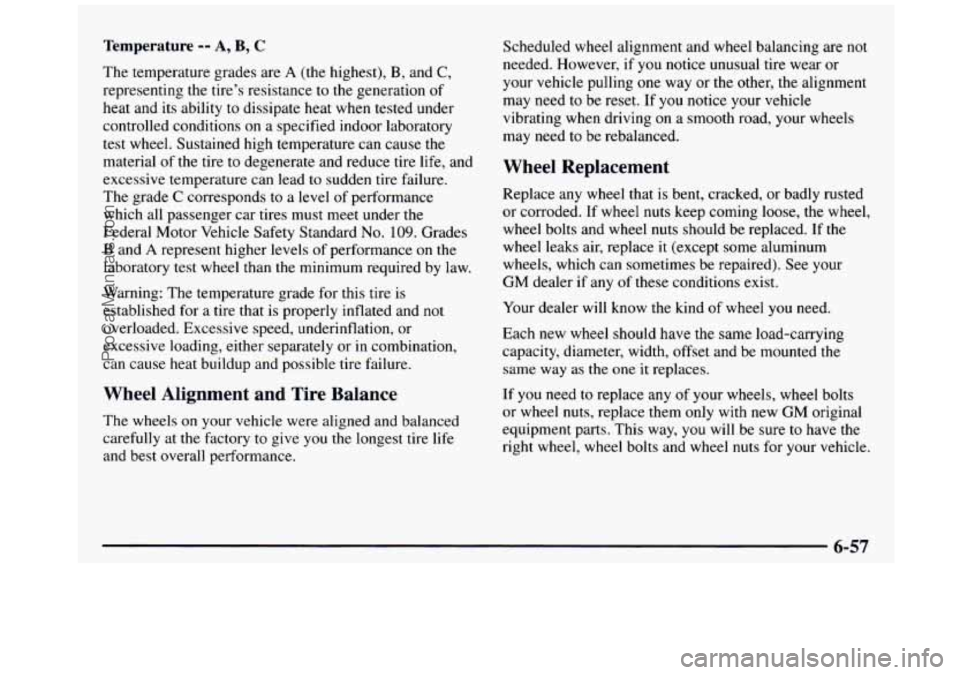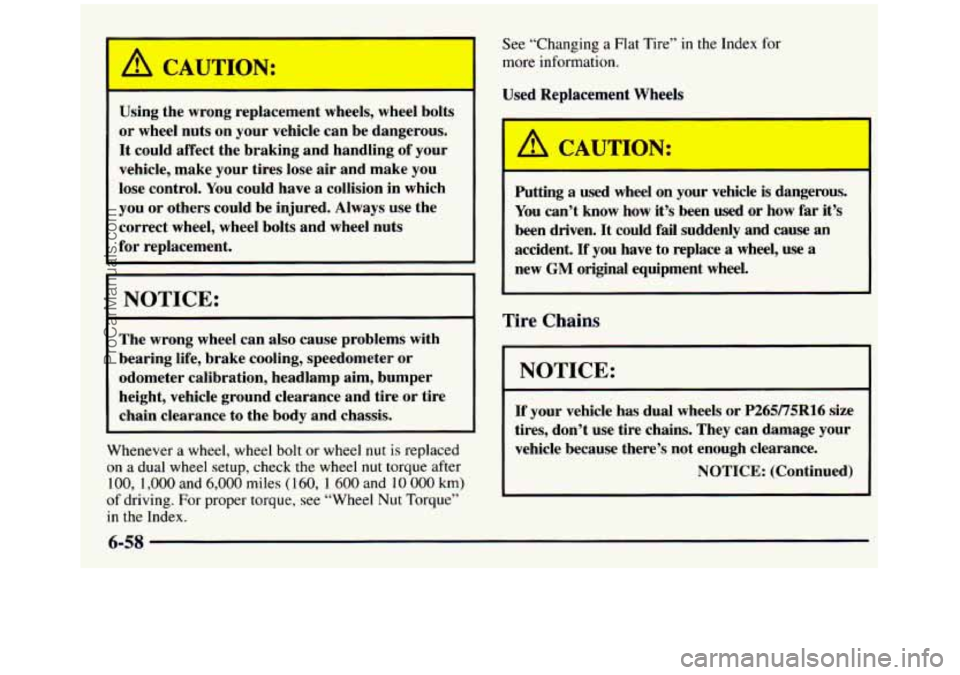Page 268 of 436
Front Position Rear Position
3. With UP on the ratchet facing you, raise the vehicle
by rotating the ratchet and wheel wrench clockwise.
Raise the vehicle far enough off the ground
so there
is enough room for the spare tire to fit.
~ 4. Remove all the wheel
nuts
and take off the
flat tire.
5. Remove any rust or dirt
from the wheel
bolts,
mounting surfaces and
spare wheel.
5-28
ProCarManuals.com
Page 333 of 436

Temperature -- A, B, C
The temperature grades are A (the highest), B, and C,
representing the tire's resistance to the generation of
heat and its ability to dissipate heat when tested under
controlled conditions on a specified indoor laboratory
test wheel. Sustained high temperature can cause the
material of the tire to degenerate and reduce tire life, and
excessive temperature can lead to sudden tire failure.
The grade
C corresponds to a level of performance
which all passenger car tires must meet under the
Federal Motor Vehicle Safety Standard
No. 109. Grades
B and A represent higher levels of performance on the
laboratory test wheel than the minimum required by law.
Warning: The temperature grade for this tire
is
established for a tire that is properly inflated and not
overloaded. Excessive speed, underinflation,
or
excessive loading, either separately or in combination,
can cause heat buildup and possible tire failure.
Wheel Alignment and Tire Balance
The wheels on your vehicle were aligned and balanced
carefully at the factory to give you the longest tire life
and best overall performance. Scheduled
wheel alignment and wheel balancing are not
needed. However, if
you notice unusual tire wear or
your vehicle pulling one way or the other, the alignment
may need to be reset. If you notice your vehicle
vibrating
when driving on a smooth road, your wheels
may need to be rebalanced.
Wheel Replacement
Replace any wheel that is bent, cracked, or badly rusted
or corroded. If wheel nuts keep coming loose, the wheel,
wheel bolts and wheel nuts should be replaced. If the
wheel leaks air, replace
it (except some aluminum
wheels, which can sometimes be repaired). See your
GM dealer if any of these conditions exist.
Your dealer will know the kind of wheel
you need.
Each new wheel should have the same load-carrying
capacity, diameter, width, offset and be mounted
the
same way as the one it replaces.
If you need to replace any of your wheels, wheel bolts
or wheel nuts, replace them only
with new GM original
equipment parts. This way, you
will be sure to have the
right wheel, wheel bolts
and wheel nuts for your vehicle.
ProCarManuals.com
Page 334 of 436

I a CAUTION:
Using the wrong replacement wheels, wheel bolts
or wheel nuts on your vehicle can be dangerous.
It could affect the braking and handling of your
vehicle, make your tires lose air and make you
lose control.
You could have a collision in which
you or others could be injured. Always use the
correct wheel, wheel bolts and wheel nuts
for replacement.
I NOTICE:
The wrong wheel can also cause problems with
bearing life, brake cooling, speedometer or
odometer calibration, headlamp aim, bumper
height, vehicle ground clearance and tire or tire
chain clearance
to the body and chassis.
Whenever a wheel, wheel bolt or wheel
nut is replaced
on a dual wheel setup, check the wheel
nut torque after
100, 1,000 and 6,000 miles ( 160, 1 600 and 10 000 km)
of driving. For proper torque, see “Wheel Nut Torque’’
in the Index. See
“Changing a
Flat Tire” in the Index for
more information.
Used Replacement Wheels
~
Putting a used wheel on your vehicle is dangerous.
You can’t know how it’s been used or how far it’s
been driven. It could fail suddenly and
cause an
new
GM original equipment wheel.
~ accident. If you have to replace a wheel, use a
Tire Chains
I NOTICE:
If your vehicle has dual wheels or P26975R16 size
tires, don’t use tire chains. They can damage
your
vehicle because there’s not enough clearance.
NOTICE: (Continued)
6-58
ProCarManuals.com
Page 352 of 436
Capacities and Specifications
Please refer to “Recommended Fluids and Lubricants” in the Index for more information.
Engine Type VIN Code Spark Plug Gap
“VORTEC”
4300 V6 W 0.060 inches (1.52 mm)
“VORTEC” 5000 V8 M 0.060 inches (1.52 mm)
“VORTEC”
5700 V8 R 0.060 inches (1.52 mm)
“VORTEC” 7400
V8 J 0.060 inches (1.52 mm)
Wheels and Tires
Model
C 1500
K 1500 and C/K 2500
C/K 2500 (w/C6P)
C/K
3500 (Single Rear Wheels)
C/K 3500 (Dual Rear Wheels)
C 3500 HD Front
C 3500 HD Rear
Tire Pressure
Description Torque
5 bolts (14mm) 140 lb-ft (190 N-m)
6 bolts (14mm) 140 lb-ft ( 190 Nam)
8 bolts (14mm)
140 lb-ft ( 190 N-m)
8 bolts (14mm) 140 lb-ft ( 190 N-m)
8 bolts (14mm) 140 lb-ft ( 190 N-m)
5 bolts (5/8 in.) 175 lb-ft (240 N-m)
10 bolts (5/8 in.) 175
lb-ft (240 N-m)
See the CertificatiodTire label on the rear edge of the driver’s door
or the incomplete vehicle document
in the cab.
6-76
ProCarManuals.com